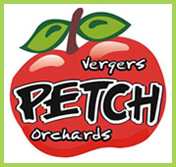Notre Histoire
 Elle débute avec l’arrivée de l’entomologiste Charles E. Petch, à l’emploi du gouvernement fédéral, dans la région de Covey hill, en 1912. Il est le premier scientifique assigné à la région dont le mandat consiste à encourager le développement des vergers.
Elle débute avec l’arrivée de l’entomologiste Charles E. Petch, à l’emploi du gouvernement fédéral, dans la région de Covey hill, en 1912. Il est le premier scientifique assigné à la région dont le mandat consiste à encourager le développement des vergers.
In 1914, Charles s’installe dans la belle municipalité de Hemmingford.
L’intérêt que portait Charles aux vergers le pousse à acheter lui-même une première ferme avec un ami, W.P. Fisher, en 1919. Les vergers de cette époque étaient surtout composés de la variété de pomme Fameuse, considérée à ce moment comme une pomme de choix. La McIntosh figurait aussi de façon importante.
Mais cette ferme ne comportait aucun bâtiment. Charles achète une vieille structure située à Covey Hill, qu’il démantèle et reconstruit chez lui. Ce bâtiment est encore utilisé aujourd’hui.
La ferme est devenue Les Vergers Petch en 1946, à la mort de M. Fisher.
 Les différentes variétés de pommes fascinaient Charles. À l’époque, il existait déjà beaucoup de types différents, tant anciens que nouveaux. Les plus populaires parmi les pommes-héritage étaient les Duchess, Dudley, Northern Spy, Wolf River et, bien sûr, la McIntosh. Parmi les nouvelles on retrouvait la Melba, Hume, Tolman Sweet et Scott Winter, toutes presque oubliées maintenant.
Les différentes variétés de pommes fascinaient Charles. À l’époque, il existait déjà beaucoup de types différents, tant anciens que nouveaux. Les plus populaires parmi les pommes-héritage étaient les Duchess, Dudley, Northern Spy, Wolf River et, bien sûr, la McIntosh. Parmi les nouvelles on retrouvait la Melba, Hume, Tolman Sweet et Scott Winter, toutes presque oubliées maintenant.
Après la guerre, en 1946, deux des fils de Charles, Charles Marshall et Robert Francis, s’associent à leur père et achètent deux lots de terre au sud du village de Hemmingford.
Les hommes commencent immédiatement à faire la propagation de leurs propres arbres, surtout des McIntosh.
Le fils de Robert, Tim, travaille à temps plein dans les vergers depuis 1984. Il en est maintenant le directeur.
Depuis, plusieurs nouvelles variétés ont été introduites : la Honeycrisp, Jonagold, Ginger Gold et Russet, pour ne nommer que celles-là. De plus, la modernisation des pratiques en pomiculture durant les 20 dernières années encourage une tendance vers les arbres nains, facilitant ainsi la cueillette, l’entretien et l’amélioration de la qualité des fruits.
Aujourd’hui, le verger emploie 4 personnes à plein temps. Au moment de la récolte, plus de 30 personnes participent au travail requis pour ramasser les fruits.
Les variétés de pommes et leur méthode de production sont en perpétuel perfectionnement afin de satisfaire les consommateurs. Les Vergers Petch sont l’exemple parfait de ce qui arrive lorsque le passé rejoint le présent lorsque le premier souci est la qualité.



